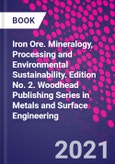Iron Ore: Mineralogy, Processing and Environmental Sustainability, Second Edition covers all aspects surrounding the second most important commodity behind oil. As an essential input for the production of crude steel, iron ore feeds the world's largest trillion-dollar-a-year metal market and is the backbone of the global infrastructure. The book explores new ore types and the development of more efficient processes/technologies to minimize environmental footprints. This new edition includes all new case studies and technologies, along with new chapters on the chemical analysis of iron ore, thermal and dry beneficiation of iron ore, and discussions of alternative iron making technologies.
In addition, information on recycling solid wastes and P-bearing slag generated in steel mills, sustainable mining, and low emission iron making technologies from regional perspectives, particularly Europe and Japan, are included. This work will be a valuable resource for anyone involved in the iron ore industry.
Please Note: This is an On Demand product, delivery may take up to 11 working days after payment has been received.
Table of Contents
1. Introduction: overview of the global iron ore industry2. Mineralogical, chemical and physical characteristics of iron ore
3. XRD analysis and evaluation of raw and sintered iron ore
4. Automated optical image analysis of natural and sintered iron ore
5. Quantitative analysis of iron ore using SEM-based technologies
6. Characterization of iron ore by visible and infrared reflectance and Raman spectroscopie
7. Extraction techniques of iron ore
8. Comminution and classification technologies of iron ore
9. Physical separation of iron ore: magnetic separation
10. Nonmagnetic physical separation technologies of hematitic/geothitic iron ore including dry separation
11. Physiochemical separation of iron ore
12. Chemical separation of iron ore
13. Thermal beneficiation
14. Application of biotechnology in iron ore beneficiation
15. Iron ore sintering
16. Iron ore pelletization
17. Blast furnace iron making
18. Alternative ironmaking processes
19. Sintering emissions and their mitigation technologie
20. Utilization of biomass as an alternative fuel in ironmaking
21. Life cycle assessment of iron ore mining and processing
22. Sustainable mining
23. Ironmaking in japan
technologies for low grade raw materials, low carbon and environmental solution
24. Low Carbon iron making technologies?- an European approach
25. Applications and challenges of biomass materials in iron and steel industry








